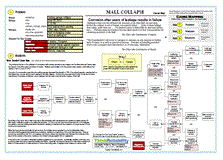A fresh look at an incident that was mapped and originally posted October 30, 2014
The problems that led to the fatal parking garage collapse at Algo Centre Mall in Elliot Lake, Ontario were present over its thirty-plus year history says the Report of the Elliot Lake Commission of Inquiry. Multiple opportunities to fix the problem were missed, culminating in the deaths of two on June 23, 2012. Says the report, “Although it was rust that defeated the structure of the Algo Mall, the real story behind the collapse is one of human, not material failure.”
Problems not identified
Yes, corrosion of a connection supporting the parking garage decreased its strength to 13% of its original capacity, meaning that on that fateful day, one car driving over it resulted in its fatal collapse. But the more important story is that of how the corrosion was allowed to increase unchecked, due to leakage that had been noted since the opening of the mall.
Multiple causes
Multiple causes were discovered resulting in the fatal parking garage collapse. The report that addresses them and suggests improvement is more than 1,000 pages long. Though the detail in the report is outstanding, an overview of the information from the report can be diagrammed in a Cause Map, or visual root cause analysis, allowing a one-page overview that clearly shows the cause-and-effect relationships.
Identify the impact to the goals
It’s important to begin with the impact to the goals. Doing so gives a starting point – and focus – to the cause-and-effect questioning. In this case, the safety goal was impacted due to the 2 fatalities and 19 injuries caused by the collapse. The mall experienced severe damage, and the rescue and response efforts were comprehensive and time-consuming. Additionally, an engineer was criminally charged due to negligence from issues with the mall’s structural integrity.
Determine the causes
The fatalities, property damage, and rescue efforts all resulted from the catastrophic collapse of the mall’s rooftop parking structure. The collapse was caused by the sudden failure of a connector. Material failure results from stress on an object overcoming the strength of the object. In this case the stress on the object was a single vehicle driving over the connection in question (evidenced by a video of the collapse). The strength of the connection had been significantly reduced due to corrosion, caused by the continuous ingress of water and chlorides on the unprotected beam.
The leakage was found to stem from a faulty initial design of the waterproofing system from construction of the mall in 1979. Specifically, the architect’s suggestions regarding waterproofing were ignored due to cost and land availability concerns, and the waterproofing system was installed during suboptimal weather because of construction delays. After construction, the architect signed off on the design without inspecting the site, beginning the first in a long list of failings that would eventually cost two women their lives.
Over the years, there were multiple warnings (not the least, the need to use buckets to collect leaking water on a fairly constant basis) that were never resolved. According to the report, the problem was never fully addressed with maintenance and repairs but rather pushed off with cheap, ineffective repairs or by selling the structure (as happened twice in its history). For the most part, the local government did not investigate complaints or enforce building standards, apparently unwilling to interfere with the operation of a large source of local revenue and employment
When the local government finally did get involved and issued an Order to Remedy in 2009, the building owner appeared to provide deliberately false information that suggested that repairs were underway, leading to a rescinding of the order later that year. After an anonymous complaint in late 2011, an engineer with a suspended license performed a visual-only inspection which had to be signed off by a licensed engineer. After it was signed, the engineer testified that he had changed the contents of the report at the request of the owner, leading to the criminal charges against him for negligence.
Lessons learned
Although plenty of failings were discussed in the report, it states very clearly, “This Commission’s role is not to castigate or chastise; its only purpose in finding fault, if it must, is to seek to prevent recurrence. Criticism of prevailing practices serves only to suggest their improvement or, if necessary, elimination.” In the report, the Commission discusses multiple suggestions for improvement – specifically clarifying, enforcing, and providing public information regarding building standards. Hopefully, the lessons learned from this tragic accident will allow for implementation of these solutions to ensure that thirty years of negligence isn’t allowed to cause a fatal building collapse again.











